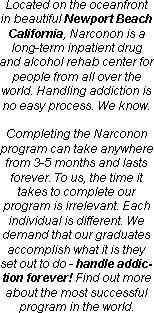
|
Navigate |
| Home |
| Kirstie Alley |
| Our 30th Anniversary |
| Never Turning Back |
| Narconon Endorsements |
| |
|
|
| |
|
|
| |
|
Facts About Drugs |
| FAQ About Ambien |
| FAQ About Ativan |
| FAQ About Cocaine |
| FAQ About Codeine |
| FAQ About Crack |
| FAQ About Darvocet |
| FAQ About Dexedrine |
| FAQ About Demerol |
| FAQ About Dilaudid |
| FAQ About Ecstasy |
| FAQ About GHB |
| FAQ About Heroin |
| FAQ About Hydrocodone |
| FAQ About Ketamine |
| FAQ About Lortab |
| FAQ About LSD |
| FAQ About Marijuana |
| FAQ About Morphine |
| FAQ About Meth |
| FAQ About Methadone |
| FAQ About Opiates |
| FAQ About Opium |
| FAQ About Oxycontin |
| FAQ About Percocet |
| FAQ About Percodan |
| FAQ About Ritalin |
| FAQ About Rohypnol |
| FAQ About Ultram |
| FAQ About Valium |
| FAQ About Vicodin |
| FAQ About Xanax |
  |
|
Resources |

|


 Print this article |  Send this article to a friend |  Add to Favorites |
FAQ
About Crack
Crack addiction is one of society's greatest problems today. Individuals addicted to crack will do almost anything to get the drug. It has penetrated all levels of our society, rich, poor, and everyone in between. Family members connected to crack addicts live in chaos and confusion. Not understanding the underlying mechanics of cocaine addiction. At Narconon we do understand crack addiction. Narconon Southern California is a leader in the field of cocaine addiction treatment since 1971. If you have a loved one addicted to cocaine, we can help.
Q.)
What is crack cocaine?
A.)The
chemical cocaine hydrochloride is commonly known as crack. Some users chemically
process cocaine in order to remove the hydrochloride. This process is called "freebasing"
and makes the drug more potent. "Crack" is a solid form of freebased
cocaine. It is called "crack" because it snaps and cracks when heated
and smoked.
Since crack is an already prepared form of freebased cocaine,
the user does not have to buy the equipment or be exposed to the explosive chemicals
associated with freebasing. Crack is most often packaged in vials or plastic bags
and sold in small quantities, usually 300-500mg or enough for two to three inhalations.
In the 1970s cocaine was expensive and considered a "status" drug. The
introduction of inexpensive crack increased the accessibility of this substance,
and crack has become the drug of choice for many drug users, especially inner-city
disadvantaged youth. Crack's convenience, ease of concealment, wide availability,
and low cost has increased its use. The fact that it is smoked rather than snorted
or injected (ingestion methods associated with the stigma of being a "junkie")
has contributed to its popularity.
Q.) What is the difference between crack and cocaine?
A.) Crack is made from cocaine in a process called freebasing, in which cocaine powder is cooked with ammonia or sodium bicarbonate (baking soda) to create rocks, chips, or chunks that can be smoked. The term crack refers to the crackling sound that is heard when the mixture is smoked. Crack is usually smoked in a pipe. Because it's smoked, crack cocaine effects are felt more quickly and they are more intense than those of powder cocaine. However, the effects of smoked crack are shorter lived than the effects of snorted powder cocaine.
Q.) How is crack used?
A.) The same way that freebase is used, namely, by placing the substance in a glass pipe (or hash pipe) with a fine mesh screen under it, then heating it and inhaling the vapors. The vapors of the freebase are absorbed through the lungs into the bloodstream and transported to the brain within 10-15 seconds. One inhalation will produce a degree of intoxication usually lasting 10-15 minutes.
Q.) What are the physical effects of crack cocaine addiction?
A.) Below is a list of physical effects of crack addiction:
- Changes in blood pressure, heart rates, and breathing rates
- Nausea
- Vomiting
- Anxiety
- Convulsions
- Insomnia
- Loss of appetite leading to malnutrition and weight loss
- Cold sweats
- Swelling and bleeding of mucous membranes
- Restlessness and anxiety
- Damage to nasal cavities
- Damage to lungs
- Possible heart attacks, strokes, or convulsions
Crack
is particularly dangerous for several reasons:
Crack is inhaled and
rapidly absorbed through the lungs, into the blood, and carried swiftly to the
brain. The chances of overdosing and poisoning leading to coma, convulsions, and
death are greatly increased. Crack's rapid rush-5 to 7 minutes of intense pleasure-
quickly subsides, leading to depression that needs to be relieved by more crack.
This cycle enhances the chances of addiction and dependency. Because of the brief
high, users are constantly thinking about and devising ways to get more crack.
Psychologically, the drug reduces concentration, ambition, and drive, and increases
confusion and irritability, wreaking havoc on users' professional and personal
lives. Habitual use may lead to cocaine psychosis, causing paranoia, hallucinations,
and a condition known as formication, in which insects or snakes are perceived
to be crawling under the skin. The paranoia and depression can instigate violent
and suicidal behavior. The side effects of adulterants increase cocaine's risks.
The drug is often cut with one or more of any number of other substances, such
as the cheaper drugs procaine, lidocaine, and benzocaine, and substances that
pose no serious risks, such as sugars (mannitol and sucrose), or starches. However,
when quinine or amphetamines are added, the potential for serious side effects
increases dramatically.
Q)
When are the effects felt from smoking crack?
A) Facilitated by the
large surface area of the lungs' air sacs, cocaine administered by inhalation
is absorbed almost immediately into the bloodstream, taking only 19 seconds to
reach the brain. However, only 30 to 60 percent of the available dose is absorbed
due to incomplete inhalation of the cocaine-laden fumes and variations in the
heating temperature.
Crack smokers achieve maximum physiological effects
approximately two minutes after inhalation. Maximum psychotropic effects are attained
approximately one minute after inhalation. Similar to intravenous administration,
the physiological and psychotropic effects of inhaled cocaine are sustained for
approximately 30 minutes after peak effects are attained.
During the
early use of crack the effects include:
- Magnification of pleasure, euphoria
- Alertness and in some cases - hyper-alertness
- Increased and sometimes a (grandiose) sense of well being
- Decreased anxiety
- Lower social inhibitions: more sociable and talkative
- Heightened energy, self-esteem, sexuality and emotions aroused by interpersonal experiences
- Appetite loss; weight loss
After compulsive use the effects of crack are:
- Extreme euphoria - "mental orgasm"
- Uninhibited
- Impaired judgment
- Grandiosity
- Impulsively
- Hyper sexuality
- Hyper vigilance
- Compulsivity
- Extreme psychomotor activation/agitation
- Anxiety; irritability; argumentative
- Transient panic
- Paranoia
- Terror of impending death
- Poor reality testing; delusions
- Extreme weight loss
Q) How does crack work?
A) Crack works on the automatic nervous system. The automatic nervous system controls the sympathetic system which speeds everything up such as the heart and breathing. The autonomic nervous system also controls the para-sympathetic system which does the exact opposite (slows things down). This is why when people smoke the crack they get hyper. Crack works by one of the brains neuro transmitters releasing all the dopamine at once (dopamine is a chemical in the brain which releases feelings of pleasure. When we laugh a slight amount of dopamine is released and this makes you feel good). After this dopamine has been released, Crack can, in some cases, block the re-uptake of the dopamine. If this happens the person will now find it a mission to get any sort of pleasure.
Q)
What complications are associated with smoking crack during pregnancy?
A) Crack and Pregnancy:
- increased incidence of still births
- increased incidence of miscarriages
- premature (often fatal) labor and delivery
- in males, the cocaine in crack may attach to the sperm causing damage to the cells of the fetus.
- babies
exposed to cocaine experience painful and life threatening withdrawal, are irritable,
have poor ability to regulate their own body temperature and blood sugar and are
at increased risk of having seizures.
Effects of Crack on the Fetus:
- seizures or strokes
- cerebral palsy
- mental retardation
- vision and hearing impairments
- urinary tract abnormalities
- autism
and learning disabilities
Q) How widespread is cocaine and crack addiction?
- In 1997, there were approximately 1.5 million regular users of crack cocaine or powdered cocaine.
- 1-tenth of the population - over 22 million people have tried cocaine or crack cocaine.
- Each day 5,000 more people will experiment with cocaine or crack cocaine.
- Cocaine is a $35 billion illicit industry now exceeding Columbia's #1 export, coffee.
- 1 in 10 workers say they know someone who uses cocaine or crack cocaine on the job.
Q)
What are the legal consequences of crack cocaine?
A) Crack cocaine
is the only drug for which the first offense of simple possession can trigger
a federal mandatory minimum sentence. Possession of 5 grams of crack will trigger
a 5 year mandatory minimum sentence. "Simple possession of any quantity of
any other substance by a first-time offender-including powder cocaine-is a misdemeanor
offense punishable by a maximum of one year in prison." (21 U.S.C. 844.)
Source: US Sentencing Commission, Special Report to Congress: Cocaine
and Federal Sentencing Policy (Washington DC: US Sentencing Commission, February
1995), p. iii.
In federal court today, low-level crack dealers and first-time offenders sentenced
for trafficking of crack cocaine receive an average sentence of 10 years and six
months. This is:
--only
18% less than the average prison sentence received by those who committed murder
or manslaughter (153 months);
--59% longer than the average prison sentence
received by rapists (79 months);
--38% longer than the average prison sentence
received by those guilty of weapons offenses (91 months).
Source:
US Sentencing Commission, Special Report to the Congress: Cocaine and Federal
Sentencing Policy (Washington DC: US Sentencing Commission, February 1995), p.
150; Bureau of Justice Statistics, Sourcebook of Criminal Justice Statistics 1996
(Washington DC: Bureau of Justice Statistics, 1997), p. 476, Table 5.58.
The Sentencing Commission also notes a problem regarding "prosecutorial and
investigative sentencing manipulation. For example, because powder cocaine is
easily converted into crack cocaine and because the penalties for crack cocaine
offenses are significantly higher than for similar quantity powder cocaine offenses,
law enforcement and prosecutorial decisions to wait until powder has been converted
into crack can have a dramatic impact on a defendant's final sentence."
Source: US Sentencing Commission, Special Report to the Congress: Cocaine
and Federal Sentencing Policy (Washington, DC: US Sentencing Commission, April
1997), p. 8.
If you have a problem with crack addiction call Narconon Southern California drug rehab center, we can help 1800 US NO DRUGS

comment corner
 |
| drug rehabilitation saving taxpayers |
California taxpayers are saving more money than expected due to ... |
 |
| Study: Marijuana Causes Lung Damage |
New research finds that smoking three or four marijuana cigarettes ... |
 |
| Thanks to Online Pharmacies, Addiction Can Be Just a Click Away |
WASHINGTON -- Kelly Knable, a 34-year-old mother of three from ... |
 |
| Balancing pain and drug addiction |
Over the past two decades, two conflicting medical ideas have ... |
 |
| Clean break |
... |
 |
| State officials create prescription drug abuse task force |
TALLAHASSEE, Fla. -- State officials on Friday announced the creation ... |
 |
| Florida system often fails to catch Medicaid abuse at source |
FORT LAUDERDALE, Fla. - (KRT) - The victim's skin was ... |
 |
| Marijuana's rising threat: For more kids, use turns into addiction |
John Brown experimented with marijuana at age 10, and it ... |
 |
| Student gets state prison term for selling marijuana |
EASTON -- David Messina had his whole life ahead of ... |
 |
| Man charged in cocaine case forfeits $585,000 |
An Iowa truck driver arrested by Kentucky Vehicle Enforcement officers ... |
 |
| Cocaine Curtails Body's Ability to Cool Off |
In addition to triggering life-threatening cardiovascular episodes, cocaine can be ... |
 |
| Science for Cops |
I admit it: I'm a Law & Order fan. ... |
 |
| New Gene Therapy Could Help Quell Alcoholic Cravings |
One prevailing view of addiction holds that alcohol and other ... |
 |
| One Dose of Cocaine Primes the Brain for Addiction |
It isn't a myth: one dose of cocaine is all ... |
 |
| Marijuana Firmly Linked to Infertility |
Scientists from the University of Buffalo have smoked out what ... |
 |
| Moderate Alcohol Consumption Clouds Brain's Ability to Detect Mistakes |
It's common knowledge that a brain on booze doesn't function ... |
|
Narconon Pictures |
|
   |
|